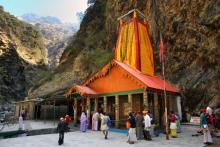
Yamunotri Temple
Yamunotri Temple is a Hindu temple devoted to the goddess Yamuna and is situated in the Uttarkashi district of Uttarakhand, India.
Yamunotri is an integral part of the Char Dham pilgrimage, which includes Gangotri, Kedarnath, and Badrinath, constituting the four most revered Hindu pilgrimages in the Himalayas.
This serene mountain village, with the focal point being the Yamunotri Temple, attracts numerous devotees annually and marks the beginning of the Char Dham Yatra pilgrimage season (from May to October). This sacred journey begins at Yamunotri, then proceeds to Gangotri, and finally to Kedarnath and Badrinath.
Nestled within a narrow gorge near the source of the Yamuna River, the Yamunotri Temple is dedicated to Yamuna, considered the second-most sacred river after the Ganges. It is believed that a bath in the waters of the Yamuna safeguards one from an untimely demise.
Yamunotri Temple Mythology
According to Hindu mythology, Yamunotri is regarded as the origin of the Yamuna River and is one of the four sacred sites in India's Char Dham pilgrimage.
In ancient legends, Yamunotri was the abode of the sage Asit Muni, who resided along the banks of the Yamuna and was renowned for his unwavering devotion to the goddess. Although the present temple was constructed in the 19th century by Hindu King Narendra Shah, references to this site can be found in ancient Hindu scriptures.
In Hindu mythology, Yamuna is recognized as the daughter of the sun god Surya and the sister of Yama, the god of death. She is venerated as a symbol of purity and is believed to purify the souls of those who bathe in her waters. Natural hot springs surround the temple, and it is customary for pilgrims to take a dip in these healing waters before visiting the sacred shrine.
Yamunotri Temple History
The shrine, situated in a picturesque valley at an elevation of 3080 meters above sea level, houses an idol of the goddess Yamuna that was discovered within a glacier.
Yamunotri was designated as one of the eight Shakti Peethas by Adi Shankara in the 9th century CE. It is linked to legends revolving around the divine consort of Lord Shiva, Sati, or Parvati.
Long ago, Sati engaged in intense penance at this very place for a million years, and after attaining liberation from her earthly existence, she merged with Lord Shiva.
Best Time To Visit Yamunotri
Several factors play a role in determining the optimal time to visit Yamunotri, including tourism trends, cultural considerations, and climatic conditions. In this article, we will explore these factors to ascertain the ideal time for a visit to Yamunotri.
Yamunotri holds immense significance for Hindus, with a belief dating back to ancient times that it was established by Lord Shiva when he discovered the goddess meditating.
The journey to Yamunotri typically takes several days starting from Rishikesh, a well-known hill station in Uttarakhand.
The most favorable times to visit Yamunotri are during the winter and summer seasons.
However, it's worth noting that winters may bring more chances of rainfall and cooler daytime temperatures, which can make daylight hours challenging. Additionally, nights during winter can become quite chilly.
For a more comfortable visit, the prime season to explore the Yamunotri temple is during the autumn season.
☀️Summer (May to June)
This is the peak season to visit Yamunotri.
Yamunotri is a well-liked pilgrimage site that draws a significant influx of pilgrims during this season.
When visiting Yamunotri during the peak season, you'll be greeted by the lush green landscapes. Along the trekking route, you can delight in the sight of exquisite flowers, trees, and abundant vegetation.
⛈️Monsoon (July to November)
July to November is the moderate season to visit Yamunotri.
In this season, the climate is typically enjoyable, with temperatures fluctuating between 15°C to 25°C. While there might be sporadic rainfall, the majority of days are characterized by sunshine and clear skies.
❄️Winter (December to April)
December to April is the off-season
During this season, you can expect extremely cold weather, with temperatures varying from -5°C to 10°C. There's a possibility of snowfall, and the trekking route may be inaccessible due to heavy snowfall.
The off-season aligns with significant festivals in the area, including Makar Sankranti and Basant Panchami. These festivals are observed with immense enthusiasm in Yamunotri, adding a cultural dimension to your visit.
How To Reach
✈️ By Air
The closest airport to Gangotri is Jolly Grant Airport (Airport Code - DED) located 26 km from Rishikesh. From there, you can either rent a taxi or take a bus to reach your destination.
🚝 By Train
Trains to Haridwar and Dehradun operate regularly throughout the year. From either of these cities, you can choose to hire a taxi or take a bus to your destination.
🚗 By Road
The motorable roads conclude at Janki Chatti. To reach Yamunotri, you'll need to undertake a trek of approximately 5-6 kilometers. For those looking to ease the journey, options such as ponies or palanquins are available.

